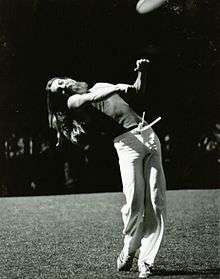Throwing

.jpg)
Throwing is the launching of a ballistic projectile by hand. This action is only possible for animals with the ability to grasp objects with their hands (mainly primates).
Humans, being bipedal, have a wide variety of throwing techniques and abilities. These have been employed in warfare – first through rock-throwing, then refined weapon-throwing (e.g. spear, throwing axe), and into modern day with hand grenades and tear gas canisters. Throwing is used in many sports and games, particularly ball games, and in throwing sports the action is the main determiner of the outcome. These serve as forms of recreation and exercise in society.
History and prehistory
Humans are believed to be unusually good throwers due to their high dexterity and good timing capabilities, and it is believed that this is an evolved trait. Evidence of hominid throwing dates back 2 million years to homo erectus.[1] The 90 mph throwing speed found in many athletes far exceeds the speed at which chimpanzees can throw things, which is about 20 mph.[1] This ability reflects the ability of the human shoulder muscles and tendons to store elasticity until it is needed to propel an object.[1]
Types
Types of throws include overhand throws, underhand throws and using both hands. Overhand throws are thrown predominantly above the shoulder, underhand throws below. Overhand throws are usually significantly faster, and ball speeds of 105 miles per hour (169 km/h) have been recorded in baseball.[2]
Thrown objects are often intentionally spun for stability or aerodynamic effects, this mostly occurs with non spherical objects like discuses, knives, hammers and flying discs.
Overhand throwing motion
The overhand throwing motion is a complex motor skill that involves the entire body in a series of linked movements starting from the legs, progressing up through the pelvis and trunk, and culminating in a ballistic motion in the arm that propels a projectile forward. It is used almost exclusively in athletic events. The throwing motion can be broken down into three basic steps: cocking, accelerating, and releasing.
Desired qualities in the action produce a fast, accurate throw. These qualities are affected by the physical attributes of the thrower like height, strength, and flexibility. However it is mainly the throwing motion mechanics and the thrower's ability to coordinate them that determines the quality of the throw. Determining the desired qualities of the throwing motion is difficult to assess due to the extremely short amount of time that it takes professionals to perform the motion.
Uses

Thrown weapons
Throwing is used for propelling weapons such as stones or spears at enemies, predators, or prey.
- Knife throwing, the art of throwing a knife at a target
- Spear throwing was used and until relatively recent times was the predominant mode of weaponry used in warfare
- Throwing axes are thrown, usually overhand
- Boomerangs (throwing sticks) are used by Aboriginals for hunting purposes.
- Shurikenjutsu are traditional Japanese thrown weapons
- Hand grenades are thrown explosives
Sports and games

- Pitching or bowling in bat-and-ball games, e.g. cricket, baseball, softball
- Throwing of balls and clubs is used in juggling
- Bowling
- Darts
- Flying disc games
Track and field contains four major throwing events: discus throw, hammer throw, javelin throw and shot put. The weight throw is the fifth most common field throwing event, while the club throw is unique to disability athletics.
Sexual differences
Males are often found to be better at throwing. However, it remains unclear whether this is biologically or culturally based. Research by MythBusters found that men and women throw almost equally well with their non-dominant hand, suggesting that the sexual differences were probably due to differences in training.[3]
See also
References
- 1 2 3 Melissa Hogenboom, "Origins of human throwing unlocked", BBC News (26 June 2013).
- ↑ Pepin, Matt (2010-08-26). "Aroldis Chapman hits 105 mph". Boston.com. Archived from the original on 31 August 2010. Retrieved 2010-08-30.
- ↑ "'MythBusters' Tests 'Throwing Like A Girl' Stereotype (VIDEO)". Huffington Post. 30 May 2013. Retrieved 2016-10-27.
External links
![]() Media related to Throwing at Wikimedia Commons
Media related to Throwing at Wikimedia Commons